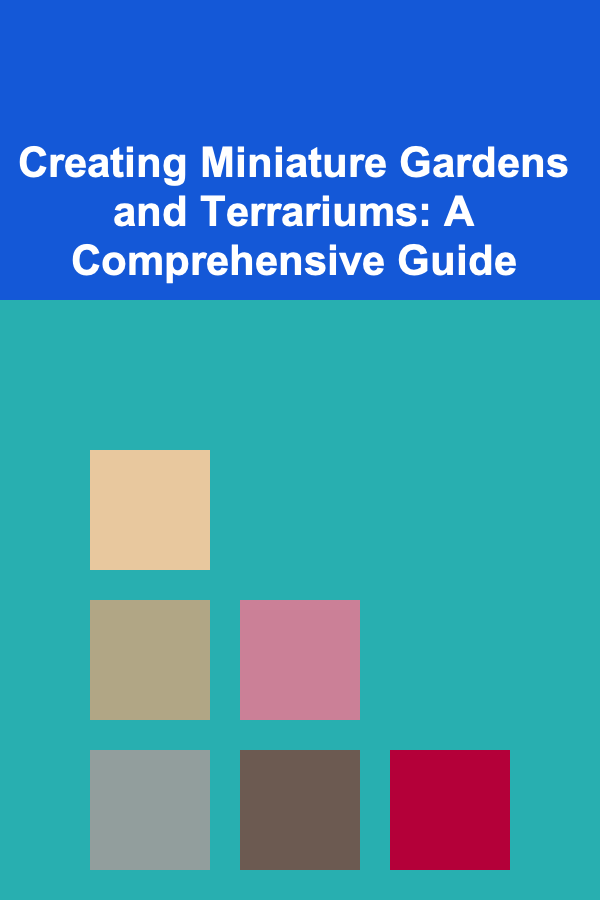
Creating Miniature Gardens and Terrariums: A Comprehensive Guide
ebook include PDF & Audio bundle (Micro Guide)
$12.99$5.99
Limited Time Offer! Order within the next:

Miniature gardens and terrariums offer a captivating way to bring nature indoors, allowing you to cultivate tiny ecosystems in glass containers or within the confines of a scaled-down landscape. These miniature worlds are not only aesthetically pleasing but also provide a rewarding and engaging horticultural experience. Whether you're a seasoned gardener or a complete novice, the art of creating miniature gardens and terrariums is accessible and endlessly customizable. This comprehensive guide will walk you through the process, from selecting the right container and plants to maintaining your miniature ecosystem for years to come.
Understanding Miniature Gardens and Terrariums
While often used interchangeably, miniature gardens and terrariums have distinct characteristics:
- Miniature Gardens: These are essentially scaled-down versions of traditional gardens, often planted in open containers like pots, troughs, or even repurposed objects. They feature miniature plants, pathways, furniture, and other decorative elements to create a whimsical and realistic landscape. Drainage is crucial for miniature gardens as they are exposed to the air and elements.
- Terrariums: Terrariums are enclosed environments, typically in glass containers, that create a self-sustaining ecosystem. They can be open or closed, with closed terrariums requiring less watering due to the condensation cycle. Terrariums are ideal for humidity-loving plants and require careful monitoring of moisture levels.
The choice between a miniature garden and a terrarium depends on your aesthetic preferences, the types of plants you wish to grow, and the level of maintenance you are willing to provide.
Choosing the Right Container
The container is the foundation of your miniature garden or terrarium, and its selection is a critical first step.
For Miniature Gardens:
- Material: Consider materials like terracotta, ceramic, plastic, or even repurposed items like old sinks or wagons. Terracotta allows for better drainage and aeration, while plastic is lightweight and durable. Ceramic offers a decorative element.
- Size: The size of the container depends on the scale of the miniature garden you envision. Larger containers offer more space for plants and decorative elements, while smaller containers are ideal for compact designs.
- Drainage: Drainage is essential. Ensure your container has drainage holes or be prepared to create a drainage layer at the bottom. Without proper drainage, the soil will become waterlogged, leading to root rot and plant death.
- Shape: Experiment with different shapes to create unique landscapes. Rectangular containers are suitable for traditional gardens, while round or irregular shapes can create more naturalistic settings.
For Terrariums:
- Material: Glass is the preferred material for terrariums, allowing for optimal light penetration and visibility. Choose clear glass to showcase the beauty of your miniature ecosystem.
- Type: Open terrariums have an opening that allows for air circulation, while closed terrariums are sealed, creating a self-sustaining environment. Choose the type that best suits the plants you wish to grow.
- Size and Shape: Terrariums come in various sizes and shapes, from small jars to large apothecary bottles. Consider the size and shape of your plants when selecting a container. Avoid containers that are too narrow, as they can restrict plant growth.
- Lid (for closed terrariums): A tight-fitting lid is crucial for closed terrariums to maintain humidity levels. Glass lids are ideal for visibility and can be easily removed for maintenance.
Selecting the Right Plants
The selection of plants is crucial for the success of your miniature garden or terrarium. Consider the following factors:
For Miniature Gardens:
- Scale: Choose plants that are naturally small or can be easily pruned to maintain a miniature size. Avoid plants that grow too quickly or become too large for the container.
- Growth Habit: Consider the growth habit of the plants. Creeping plants can be used as ground cover, while upright plants can add height and structure.
- Light Requirements: Select plants with similar light requirements to ensure they thrive in the same environment.
- Water Requirements: Choose plants with similar water requirements to simplify watering. Group plants that prefer dry conditions together and those that prefer moist conditions together.
- Hardiness: Select plants that are hardy in your climate or that can tolerate indoor conditions.
Examples of Plants for Miniature Gardens:
- Dwarf conifers: These provide structure and year-round greenery. Examples include dwarf Alberta spruce, dwarf Hinoki cypress, and miniature junipers.
- Ground covers: Creeping thyme, Irish moss, and baby's tears add texture and fill in spaces.
- Succulents: Echeverias, sedums, and haworthias are drought-tolerant and come in a variety of shapes and colors.
- Herbs: Miniature varieties of rosemary, thyme, and oregano can add fragrance and culinary appeal.
- Flowering plants: Miniature pansies, violas, and alyssum provide pops of color.
For Terrariums:
- Humidity Tolerance: Choose plants that thrive in humid environments. Closed terrariums are ideal for humidity-loving plants, while open terrariums can accommodate plants that prefer drier conditions.
- Size: Select plants that are small and slow-growing to prevent them from outgrowing the terrarium quickly.
- Light Requirements: Choose plants with similar light requirements to ensure they thrive in the same environment.
- Compatibility: Avoid planting aggressive or fast-growing plants that can outcompete other plants in the terrarium.
Examples of Plants for Terrariums:
- Ferns: Maidenhair fern, button fern, and asparagus fern are well-suited for terrariums.
- Mosses: Sheet moss, cushion moss, and sphagnum moss add texture and create a naturalistic environment.
- Tropical plants: Peperomia, prayer plant, and nerve plant thrive in humid conditions.
- Air plants: Tillandsia are epiphytes that do not require soil and can be mounted on rocks or wood.
- Orchids: Miniature orchids can add a touch of elegance to terrariums.
Tip: Research the specific needs of each plant before incorporating it into your miniature garden or terrarium. Consider factors like light, water, humidity, and soil type to ensure optimal growth.
Gathering Your Supplies
Before you begin planting, gather all the necessary supplies:
For Miniature Gardens:
- Container: Choose your desired container with drainage holes.
- Potting Soil: Use a well-draining potting mix specifically formulated for container gardening.
- Drainage Material: Gravel, pebbles, or broken pottery to create a drainage layer.
- Miniature Plants: Select plants that are appropriate for the scale and environment of your garden.
- Decorative Elements: Miniature furniture, pathways, figurines, rocks, and other accessories to create a realistic landscape.
- Tools: Trowel, gardening gloves, watering can, and pruning shears.
For Terrariums:
- Container: Choose your desired glass container.
- Drainage Material: Gravel, pebbles, or activated charcoal to create a drainage layer. Activated charcoal helps to filter the water and prevent odors.
- Sphagnum Moss: To separate the drainage layer from the potting mix and prevent soil from seeping into the gravel.
- Potting Soil: Use a well-draining potting mix specifically formulated for terrariums.
- Miniature Plants: Select plants that are appropriate for the size and humidity of the terrarium.
- Decorative Elements: Rocks, wood, figurines, and other accessories to create a visually appealing environment.
- Tools: Long-handled spoon, chopsticks, spray bottle, and pruning shears.
Creating Your Miniature Garden
- Prepare the Container: Clean your container thoroughly. If using a container without drainage holes, create a drainage layer by adding a 1-2 inch layer of gravel or pebbles to the bottom.
- Add Drainage Layer: For containers with drainage holes, add a thin layer of gravel at the bottom to improve drainage. This helps prevent the soil from becoming waterlogged.
- Add Soil: Fill the container with potting soil, leaving enough space at the top for planting. The amount of soil will depend on the size and depth of the container and the root systems of your chosen plants.
- Plan Your Layout: Arrange your plants and decorative elements on the soil surface to visualize the final design. Consider the height, color, and texture of the plants to create a balanced and aesthetically pleasing composition.
- Plant Your Plants: Gently remove the plants from their containers and loosen the roots. Dig small holes in the soil and plant the plants, ensuring that the roots are covered with soil. Space the plants appropriately to allow for growth.
- Add Decorative Elements: Add miniature furniture, pathways, figurines, rocks, and other accessories to create a realistic landscape. Be creative and use your imagination to bring your miniature garden to life.
- Water Gently: Water the plants gently to moisten the soil. Avoid overwatering, as this can lead to root rot.
- Place in Appropriate Light: Place your miniature garden in a location that provides the appropriate amount of light for the plants you have chosen.
Creating Your Terrarium
- Prepare the Container: Clean your glass container thoroughly.
- Add Drainage Layer: Add a 1-2 inch layer of gravel, pebbles, or activated charcoal to the bottom of the container. The activated charcoal helps to filter the water and prevent odors.
- Add Sphagnum Moss: Place a layer of sphagnum moss on top of the drainage layer. This will prevent the potting mix from seeping into the gravel and keep the drainage layer clean.
- Add Soil: Add a layer of potting mix on top of the sphagnum moss. The amount of soil will depend on the size and depth of the container and the root systems of your chosen plants.
- Plan Your Layout: Arrange your plants and decorative elements on the soil surface to visualize the final design. Consider the height, color, and texture of the plants to create a balanced and aesthetically pleasing composition.
- Plant Your Plants: Gently remove the plants from their containers and loosen the roots. Dig small holes in the soil and plant the plants, ensuring that the roots are covered with soil. Space the plants appropriately to allow for growth. Use long-handled tools to reach into the terrarium without disturbing the plants.
- Add Decorative Elements: Add rocks, wood, figurines, and other accessories to create a visually appealing environment. Be creative and use your imagination to bring your terrarium to life.
- Water Gently: Water the plants gently to moisten the soil. Avoid overwatering, as this can lead to excessive condensation.
- Wipe the Glass: Wipe the inside of the glass with a clean cloth to remove any soil or moisture.
- Place in Appropriate Light: Place your terrarium in a location that provides the appropriate amount of light for the plants you have chosen. Avoid direct sunlight, as this can cause the terrarium to overheat.
Warning: Overwatering is a common mistake when creating terrariums. The enclosed environment retains moisture, so it is important to water sparingly. Signs of overwatering include excessive condensation, soggy soil, and yellowing leaves.
Maintaining Your Miniature Garden or Terrarium
Regular maintenance is essential to keep your miniature garden or terrarium healthy and thriving.
Watering:
- Miniature Gardens: Water when the soil feels dry to the touch. Water deeply and thoroughly, allowing excess water to drain from the drainage holes. Avoid overhead watering, as this can damage delicate plants.
- Terrariums: Water sparingly, only when the soil feels dry. The enclosed environment retains moisture, so overwatering is a common problem. Monitor the condensation levels inside the terrarium. If there is excessive condensation, remove the lid for a few hours to allow excess moisture to evaporate.
Light:
- Miniature Gardens: Provide the appropriate amount of light for the plants you have chosen. Most miniature garden plants prefer bright, indirect light.
- Terrariums: Place the terrarium in a location that provides the appropriate amount of light for the plants you have chosen. Avoid direct sunlight, as this can cause the terrarium to overheat.
Pruning:
- Miniature Gardens: Prune plants regularly to maintain their size and shape. Remove any dead or dying leaves or stems.
- Terrariums: Prune plants as needed to prevent them from outgrowing the terrarium. Remove any dead or dying leaves or stems. Use long-handled tools to reach into the terrarium without disturbing the plants.
Fertilizing:
- Miniature Gardens: Fertilize plants sparingly with a diluted liquid fertilizer during the growing season. Avoid over-fertilizing, as this can damage delicate plants.
- Terrariums: Fertilize plants very sparingly, if at all. The enclosed environment provides limited nutrients, so over-fertilizing can lead to nutrient imbalances.
Pest Control:
- Miniature Gardens: Inspect plants regularly for pests and diseases. Treat any infestations promptly with appropriate insecticides or fungicides.
- Terrariums: Inspect plants regularly for pests and diseases. Remove any infested plants immediately to prevent the spread of pests to other plants in the terrarium.
Cleaning:
- Miniature Gardens: Clean the container regularly to remove any debris or algae.
- Terrariums: Wipe the inside of the glass regularly to remove any condensation or algae.
Troubleshooting Common Problems
Even with careful planning and maintenance, you may encounter some common problems with your miniature garden or terrarium:
- Yellowing Leaves: This can be caused by overwatering, underwatering, nutrient deficiencies, or pest infestations. Adjust your watering schedule, fertilize appropriately, and treat any pest infestations.
- Root Rot: This is caused by overwatering and poor drainage. Ensure that your container has adequate drainage and avoid overwatering. Remove any affected plants and replant them in fresh soil.
- Mold Growth: This can be caused by excessive humidity and poor air circulation. Remove any mold with a cotton swab dipped in rubbing alcohol. Improve air circulation by removing the lid of the terrarium for a few hours each day.
- Algae Growth: This can be caused by excessive light and moisture. Reduce the amount of light and moisture in the terrarium. Clean the inside of the glass regularly to remove any algae.
- Leggy Growth: This is caused by insufficient light. Move the miniature garden or terrarium to a location with more light.
Adding a Touch of Whimsy: Decorative Elements
Decorative elements are what truly bring your miniature garden or terrarium to life. Consider adding:
- Miniature Furniture: Tiny benches, tables, chairs, and swings can create a cozy and inviting atmosphere.
- Pathways: Small pebbles, gravel, or moss can create winding pathways throughout the garden.
- Water Features: Miniature ponds, streams, or fountains can add a touch of tranquility. (Note: water features in terrariums require careful planning to prevent excessive humidity.)
- Figurines: Gnomes, fairies, animals, and other figurines can add personality and charm.
- Rocks and Wood: Natural elements like rocks and wood can add texture and realism.
- Miniature Buildings: Tiny houses, cottages, and castles can create a whimsical and imaginative landscape.
Inspiring Ideas for Miniature Gardens and Terrariums
- Fairy Garden: Create a magical fairy garden with miniature houses, bridges, and fairy figurines.
- Zen Garden: Design a serene zen garden with raked sand, rocks, and moss.
- Desert Landscape: Create a arid desert landscape with succulents, cacti, and sand.
- Tropical Rainforest: Replicate a lush tropical rainforest with ferns, mosses, and tropical plants.
- Beach Scene: Create a coastal scene with sand, shells, and miniature beach chairs.
Conclusion
Creating miniature gardens and terrariums is a rewarding and creative endeavor that allows you to bring the beauty of nature indoors. By carefully selecting the right container, plants, and decorative elements, you can create a miniature ecosystem that is both aesthetically pleasing and easy to maintain. With a little planning and attention to detail, you can enjoy your miniature garden or terrarium for years to come. So, gather your supplies, unleash your creativity, and embark on a journey to create your own miniature world!

How to Find Budget-Friendly Storage Solutions for Your Hobby Room
Read More
How to Plan a Family Road Trip with Fun Activities Along the Way
Read More
How to Save Space in Your Kids' Room with Creative Solutions
Read More
How to Set Up an Indoor Obstacle Course for Kids
Read More
How to Protect Your Health Data Privacy
Read More
How to Deal with Lying and Dishonesty
Read MoreOther Products

How to Find Budget-Friendly Storage Solutions for Your Hobby Room
Read More
How to Plan a Family Road Trip with Fun Activities Along the Way
Read More
How to Save Space in Your Kids' Room with Creative Solutions
Read More
How to Set Up an Indoor Obstacle Course for Kids
Read More
How to Protect Your Health Data Privacy
Read More